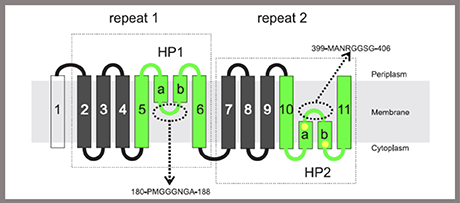Research Highlights
Dr. Juke Lolkema

Classification of bacterial transport proteins
Secondary transporters catalyze transport across the cytoplasmic membrane by coupling the translocation of the substrate to the translocation of one or more ions or another substrate. Genome sequences display an enormous diversity (>100 families) in primary structure of these transporters. The Lolkema group developed the MemGen classification of membrane proteins that uses hydropathy profile alignments to group protein families that share the same overall structurea. Available crystal structures of secondary transporters confirm the MemGen classification in four different classes that correspond to four different transport mechanisms. Low-resolution studies to support the classification resulted in a detailed structural model for the transporters of the 2-hydroxycarboxylate transporter (2HCT) familyb,c, more in particular of CitS of Klebsiella pneumoniae. Secondary transporters play a pivotal role in short catabolic pathways that generate metabolic energy and counteract acidification in lactic acid bacteria. The pathways involve decarboxylation or deamination reactions of the substrates (amino acids and di- and tricarboxylates). The group studies the energetics, genetic background and physiology of these pathwaysd-h and has successfully engineered the citrate degradation pathway in Lactococcus lactis to produce flavor compounds.
aMolec Membr Biol (1998, 2008); bMicrobiol Mol Biol Rev (2005); cCurr Opin Struct Biol (2017); dMol Microbiol (2011); eJ Biol Chem (2012); fJ Bact (2012); gJ Gen Phys (2015); hMicrobiol Open (2016);
| Last modified: | 04 July 2017 10.12 a.m. |
